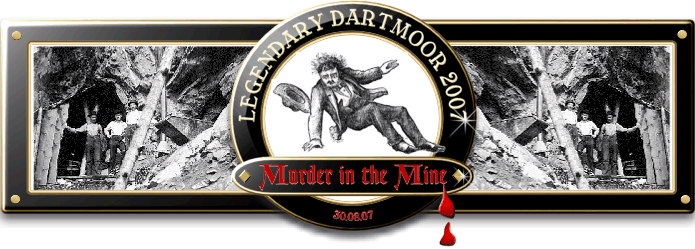
About a mile south of Tavistock are the remains of an old copper mine known as Crowndale Mine, little is known about its origins but in 1799 the mine was resurrected and re-worked. An old plan of the mine shows that in its heyday the mine had 18 shafts, the deepest of which went down 90 fathoms, these reached down into the very bowels of the earth to find the copper lode which lay at around 40 fathoms. Obviously when working at these depths the miners were constantly working with death sat on their shoulders and it was at times like this they needed to rely on each other. However a news report in The Times newspapers stated how one poor miner had more than the threat of a cave in or flood to worry about.
In 1821 a man living at St. Agnes in Cornwall was arrested following certain information given to the authorities by one Symon Pryor who lived at Redruth. The prisoner in question was a James Matthews who in 1804 was working at the Crowndale mine. Symon Pryor made a statement on oath infront of a local magistrate – the Reverend Hugh Rogers, that 16 years previous (I know the maths does not tally up) James Matthews murdered his brother-in-law, John James. One may wonder why it took so long for Pryor to bring the whole affair to the authorities? The answer to this being that eventually such a crime hangs heavy on a man’s conscience until finally he can no longer bear the burden, in this case it took 16 years to offload. But what happened in that mine to cause such torment and turmoil in Pryor’s mind?
As mentioned above, there were a number of shafts at Crowndale Mine, all driving down in search of the rich lode of copper. One night both Pryor and James were working on a late shift when they were ordered down a shaft in order to blast some rock. Both men were lowered into the blackness by means of a windlass which took them down to about 22 fathoms which is roughly 132 feet. Once down they set about boring holes for the black powder and when done James sent Pryor back up the shaft. Once he was safely out of harms way James, “laid a match to the train”, and yelled to be hauled up as quickly as possible. Above ground Pryor and Matthews were working the windlass that was hauling James up to the surface, and when James had been hoisted 5 fathoms (30ft) up Matthews let go of the windlass and told Pryor to do the same. The rope hung still and below John James could hear the train burning down to the powder and screamed for the men to wind him up. Hearing the desperate cries from below Pryor frantically resumed working the hoist when Matthews told him to let go of the handle. This order he ignored and carried on winding, again Matthews told him to stop and this time threatened to, “knock his brains out” if he didn’t obey. Once again Pryor turned a deaf ear and carried on hoisting poor James to the surface. In a fit of rage Matthews grabbed a nearby pick and smashed the hilt down onto Pryor’s arm, the shock and pain of the blow caused him to release his grip on the winding gear which sent the helpless James plummeting back down the shaft. His cries of terror were heard hurtling back into the darkness followed by a loud thud, then total silence descended. When poor James was brought to the surface he was found to have, “had his skull so dreadfully fractured that he died two days later”.
Weighed down with remorse Pryor related the horrendous story to his brother, who was the mine’s blacksmith, and some other miners when declared his intent to disclose all to the authorities. For some reason the smith and his friends decided this was not a good idea and locked Pryor in a small room at the back of the forge until the coroner had held his inquest. The final outcome of these proceedings were a jury verdict of accidental death and it was only after this decision that Pryor was released. After the verdict had been reached the smith and his colleagues managed to persuade Pryor that Matthews had a large family to support and if he was put away they would all end up in the workhouse. The thought of so many children being thrown into the dreaded workhouse was enough to secure his silence. Nobody ever disclosed the motive for Matthews evil doings and shortly after the murder Pryor moved away from the area to relive the events of that dreadful night for evermore.
The main lode of Crowndale Mine eventually enters the sett of nearby East Crebor mine and once again the grim reaper was to claim some more victims from within its depths. In 1880, following a period of heavy rainfall the river Tavy burst into a shaft where at about 70 fathoms a gang of miners were working. This deluge claimed the lives of three of the men who were drowned in the angry waters.
 Legendary Dartmoor The many aspects past and present of Dartmoor
Legendary Dartmoor The many aspects past and present of Dartmoor
